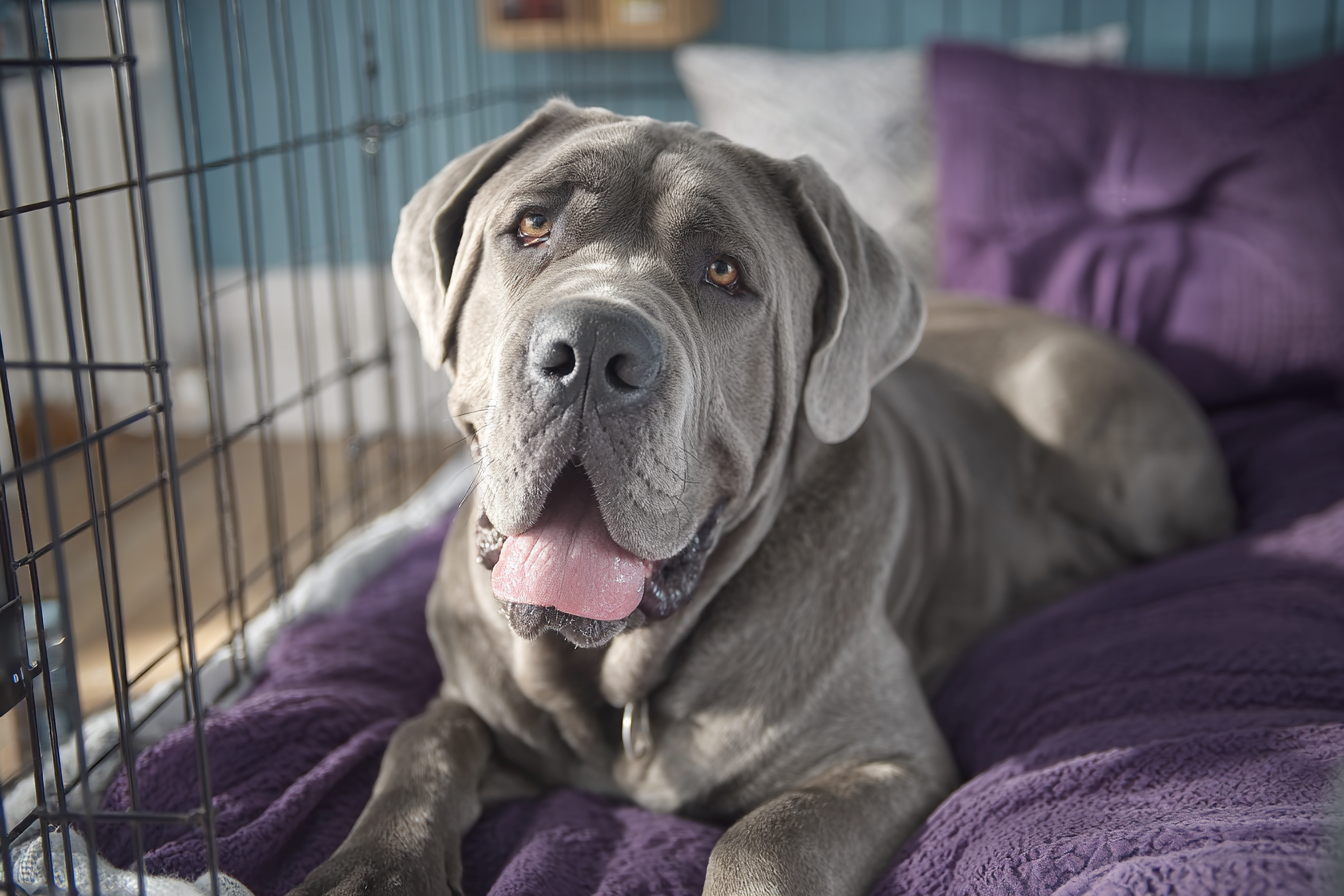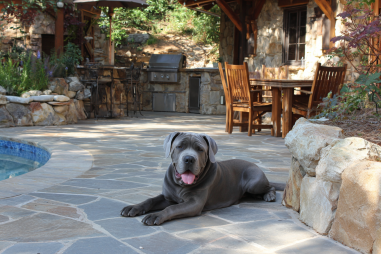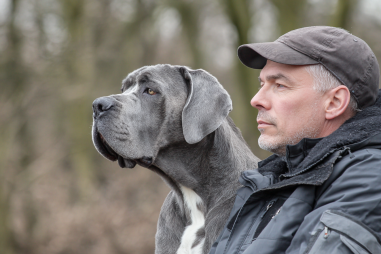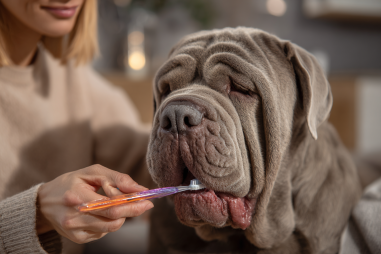Crate training is an effective way to provide your Neapolitan Mastiff with a safe and cozy environment. This breed, known for its large size and gentle temperament, particularly benefits from having a secure space they can call their own. Crate training not only helps with housebreaking and managing behavior but also creates a sanctuary that your Mastiff will appreciate. In this guide, we’ll walk you through every step of crate training your Neapolitan Mastiff, from picking the right crate to troubleshooting common issues, ensuring the process is enjoyable and stress-free for both you and your dog.
Benefits of Crate Training for Neapolitan Mastiffs
Neapolitan Mastiffs are a unique breed with specific needs, and crate training offers several advantages tailored to those needs. Here are some key benefits of crate training your Neapolitan Mastiff:
- Provides a safe haven: Mastiffs are naturally protective and sometimes shy; a crate becomes their personal refuge where they can relax and feel secure.
- Assists in housebreaking: Using a crate helps your dog learn bladder and bowel control, as they instinctively avoid soiling their sleeping area.
- Prevents destructive behavior: When unsupervised, a crate keeps your dog from chewing furniture or getting into dangerous situations.
- Aids in travel safety: Crates provide a secure way to transport your large dog, minimizing stress on the dog and driver.
- Supports veterinary care: A dog comfortable with their crate is less anxious during vet visits or hospital stays.
Given their size and strength, crate training also ensures that your Neapolitan Mastiff doesn’t accidentally cause damage to your home or themselves during periods you can’t supervise them closely.
Choosing the Right Crate Size and Type
One of the most important considerations when crate training your Neapolitan Mastiff is selecting the appropriate crate. Because these dogs grow to be quite large, the crate needs to accommodate their full size comfortably. Here are some tips on choosing the right crate:
- Size: The crate should be large enough for your Mastiff to stand up, turn around, and lie down comfortably. Measuring your dog from nose to tail and adding a few inches can help you find a suitable size.
- Type of crate: Heavy-duty metal crates are often best for Neapolitan Mastiffs due to their size and strength. These crates offer durability and ventilation. Plastic crates can be secure but may feel more enclosed, which some dogs prefer, but ensure it’s large enough.
- Portability considerations: If you plan to use the crate for travel, look for one that is sturdy yet has wheels or handles for easier transport.
- Comfort accessories: Invest in a soft cushion or blanket to make the crate inviting and cozy for your dog.
Remember that puppies will grow, so if you’re crate training a Neapolitan Mastiff puppy, it may be wise to choose a crate designed for adults and use dividers to adjust the space accordingly.
Introducing the Crate Positively
Getting your Neapolitan Mastiff comfortable with the crate is essential for successful training. Cats and smaller dogs might adapt quickly, but large breeds can sometimes find crates confining if introduced improperly. Here’s how you can positively introduce your Mastiff to their crate:
- Make the crate inviting: Place treats, toys, and their favorite blanket inside. Let your dog explore the crate on their own without force.
- Use positive reinforcement: Praise your dog and offer rewards whenever they enter or stay calmly inside the crate.
- Feed meals inside the crate: Feeding your Mastiff their dinner inside the crate helps them associate the space with positive experiences.
- Keep the door open at first: Let your dog come and go freely during initial sessions to reduce anxiety and build trust.
Patience is key. Never use the crate as punishment, as this will create negative associations and hinder progress.
Gradual Training Steps and Schedule
Neapolitan Mastiffs are intelligent but can be stubborn; a gradual and consistent crate training schedule will yield the best results. Below is a suggested step-by-step process:
- Step 1: Allow exploration — Start by leaving the crate door open and encourage your dog to explore voluntarily with treats and toys inside.
- Step 2: Short stays — Once the dog is comfortable entering the crate, encourage them to stay inside for a few minutes at a time, rewarding calm behavior.
- Step 3: Closing the door — Gently close the door while your dog is inside, gradually increasing the time the door stays shut before rewarding and letting them out.
- Step 4: Increasing duration — Extend the time your dog spends in the crate to 30 minutes, then an hour, while you stay nearby.
- Step 5: Leaving the room — Practice leaving your dog alone in the crate while you leave the room, starting with short intervals and increasing gradually.
Maintain consistency with your schedule to help your dog associate the crate with calm, safe periods. A typical crate training session should be short and positive—around 10-15 minutes multiple times a day to begin with.
Troubleshooting Common Problems
While crate training is generally successful, you might occasionally run into challenges. Here are common issues and how to address them:
- Whining or barking: This often occurs when the dog is anxious or wants attention. Ensure your dog has had enough exercise and bathroom breaks before crating, and avoid letting them out when they’re noisy to not reinforce the behavior. Wait for calm before releasing.
- Refusal to enter the crate: Revert to positive reinforcement with treats and toys, and don’t force your dog inside. Patience and gradual exposure will help.
- Chewing the crate: Provide durable chew toys and ensure the dog is getting enough physical and mental stimulation. If persistent, consider a sturdier crate or crate covers to prevent damage.
- House soiling inside the crate: This might mean the crate is too large or your dog has not yet mastered bladder control. Adjust crate size or increase potty breaks.
If difficulties persist, consulting a professional dog trainer or behaviorist familiar with large breeds like the Neapolitan Mastiff can be very helpful.
Crate Training for Travel and Safety
Once your Neapolitan Mastiff is comfortably crate trained at home, the benefits extend far beyond. Using a crate for travel ensures your dog’s safety whether in a car, plane, or other modes of transport:
- Secure in vehicles: Crates prevent distractions while driving and protect your dog in case of sudden stops or accidents.
- Air travel compliance: Many airlines require pets to be transported in approved crates, so having your dog accustomed to their crate helps alleviate travel stress.
- Temporary accommodations: In kennels or veterinary hospitals, a dog familiar with crate living will adjust faster and experience less anxiety.
When traveling, always ensure your Mastiff’s crate is well-ventilated, large enough, and equipped with familiar bedding. Bring along water and plan frequent stops for bathroom breaks and exercise if you’re on long road trips.
Crate training your Neapolitan Mastiff can be a rewarding experience for both of you. With patience, consistency, and the right approach, your dog will come to view their crate as a cherished space, enhancing their well-being and your ability to provide care and safety. Start early, stay positive, and watch your gentle giant thrive within the secure comfort of their crate.







